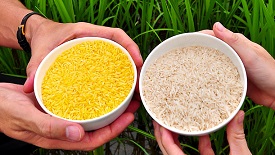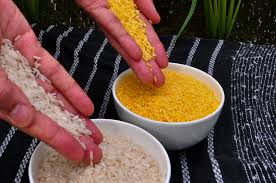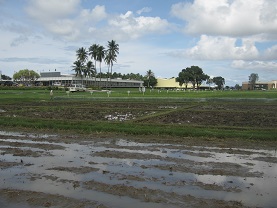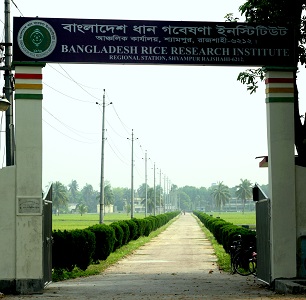Golden rice symbolizes the protracted trench war between proponents and opponents of modern biotechnology. The Swiss Ingo Potrykus of ETH Zürich is the golden man behind the golden rice. With great ardour he defends this controversial rice, and attacks the opponents of gene technology. With his colleague Peter Beyer of Freiburg University he developed the first version of this provitamin-A reinforced rice, between 1991 and 1999, the year in which he retired. But still, at the age of 85, he battles to get access to ‘his rice’ for children who have serious vitamin-A deficiencies.
Hans Tramper is professor emeritus in Bioprocess Technology at Wageningen University and reflects on the development of his subject in a series of essays. His pieces were published so far on 18 June, 30 June, 11 July, 22 July, 19 August , 10 September, 21 September, 30 September, 10 October, 31 October, 8 November, 2 December and 26 December 2018.
 Controversial rice
Controversial rice
In Essay 1 of this series I write: ‘The most extensively discussed transgene vegetal case, almost to the point of boredom, is that of golden rice.’ Googling ‘golden rice’ will produce hundreds of millions of hits. Yet, we need to discuss it here, because of the importance of this provitamin-A enriched rice. Moreover, we may witness at last, after much hassle, the first commercial production in Bangladesh and the Philippines. Easily accessible sources that treat golden rice extensively are a report by Charles M. Rader from 2001, and a booklet of VIB, the Flemish Institute for Biotechnology, from 2016.
Vitamin A deficiency
WHO, the World Health Organization, estimates that 250 million people suffer from vitamin A deficiency. In developing countries, 40 percent of children suffering from this condition is under five. UNICEF statistics show that each year, 1-2 million people die prematurely because of vitamin-A deficiency. It causes the immune system to weaken, and babies and children are especially at risk. Each year, about two million people become blind and in 60 percent of those incidents in India, China and sub-Saharan Africa, this is caused by vitamin A deficiency. Worldwide, it causes the loss of eyesight in a quarter to half a million children; half of them die with a year of becoming blind. This could be counteracted by health education, vitamin supply, gardening, food programs, and the use of genetically modified rice with an enhanced beta carotene (provitamin-A) content. The UN Standing Committee on Nutrition stresses the need for an integrated program in the battle against food shortages. I fully support this, and underlined it in my book Modern Biotechnology: a new Pandora’s Box? published in 2011. Likewise I treat the golden rice problem in other books, columns etc., like We need genetic engineering on this website.

Ingo Potrykus
Golden rice and Ingo Protykus (1933) are inextricably bound up with each other. He is the driving force behind the Golden Rice Project. In 2015, he published his autobiography as a scientist, a moving story; Potrykus is 82 then. The genetically modified rice, called golden rice because of its yellow colour, has been developed with the aim of enrichment with provitamin-A (beta carotene). Together with the transgene tomato Fravr Savr (see Essay 4.1), golden rice is looked upon as the first two transgene crops with a direct positive effect on consumers. In 2001 Ingo Protykus publishes a review article titled The ‘Golden Rice’ Tale. He says: ‘Golden rice’ fulfills all the wishes the GMO opposition had earlier expressed in their criticism of the use of the technology, and it thus nullifies all the arguments against genetic engineering with plants in this specific example.
– Golden Rice has not been developed by and for industry.
– It fulfills an urgent need by complementing traditional interventions.
– It presents a sustainable, cost-free solution, not requiring other resources.
– It avoids the unfortunate negative side effects of the Green Revolution.
– Industry does not benefit from it.
– Those who benefit are the poor and disadvantaged.
– It is given free of charge and restrictions to subsistence farmers.
– It does not create any new dependencies.
– It will be grown without any additional inputs.
– It does not create advantages to rich landowners.
– It can be resewn every year from the saved harvest.
– It does not reduce agricultural biodiversity.
– It does not affect natural biodiversity.
– There is, so far, no conceptual negative effect on the environment.
– There is, so far, no conceivable risk to consumer health.
It was not possible to develop the trait with traditional methods, etc.
Optimists might, therefore, have expected that the GMO opposition would welcome this case. As the contrary is the case, and GMO opposition is doing everything to prevent golden rice reaching the subsistence farmer, we have learned that GMO opposition has a hidden, political agenda.’
Fourteen years later, in the autobiography mentioned above, he poses the next question: ‘Why?’ and answers simply: ‘Golden rice is a GMO!’ Implicitly, he admits that it takes a lot of trouble to get transgene crops to the market. The shortcomings of the first version have now been overcome and the safety is warranted. Yet, opposition has become fiercer – simply because it is a genetically modified crop. The scientific evidence that underpins the products of gene technology in general and golden rice in particular has been strengthened to such an extent now, that it is amoral not to make use of these achievements.
Opponents
Opponents of gene technology, particularly Greenpeace, are concerned about effectiveness, the environment, social acceptance and patents, if golden rice should be introduced in Asia. On February 9, 2001, Greenpeace launches the effective campaign Fool’s gold, in which they claim that an adult, let alone a young child, would have to eat impossible amounts of golden rice in order to ingest enough vitamin A. As for the environment, they fear that recombinant genes will jump to traditional and wild rice varieties, which could have far-reaching consequences in Asia, the region of origin of rice. They suggest that golden rice may not be socially and culturally acceptable because of its yellow colour. Golden rice is royalty free, but a number of international patents on it is in the hands of multinational companies. A British NGO, ExoNexus, publishes a critical report on this issue in 2003. The patent holders have agreed that poor farmers in developing countries will not have to pay royalties if they earn less than 10,000 American dollars and do not export the rice – but how will that work in practice? Both terms will be difficult for poor farmers to prove, simply because they lack the instruments to do so. ExoNexus also states that no environmental and food safety tests have been done on golden rice, and that an assessment of any socio-economic effects is missing. They end their report stating: ‘Meanwhile, new breeds of vitamin-A-rich grains have been announced…. Even so, as with Golden Rice, those grains cannot answer the problem of hidden hunger and malnutrition, which need a far more integrated solution.’ With the latter statement, I wholeheartedly agree, as stated above.
 New developments
New developments
Meanwhile, in 2018, we have moved fifteen years onwards, and a new transgene rice variety has been developed and tested. The old version contains two daffodil genes and a gene of the bacterium Erwinia uredovora. The new variety has one bacterial gene and one gene from maize instead of the two daffodil genes. This new golden rice variety produces 23 times more provitamin-A than the old one, and therefore it will make sense to continue with this one in the battle against vitamin-A deficiency. All the more because it has been proven that a bowl with 100-150 grams of this golden rice (prepared) can ensure an intake in children between 6 and 8 of 60 percent of the recommended daily intake. A result that is corroborated by other research. Greenpeace did not succeed in discrediting these results. Nevertheless, they adhere to their 2001 website.
As for socio-economic aspects, I highlight a few points from the VIB booklet cited above. Generally, it is expected that the provitamin-A property will not have a negative environmental impact. This property is abundantly present in nature and does not carry with it any selective advantage or disadvantage for wild varieties, in case of any crossbreeding with them. Which is not likely anyway, because rice is self-pollinating? Yet, GMO regulations require extensive environmental impact assessments before a transgene crop is allowed to be grown on a commercial scale. I will return to this in the next paragraph.
We also need to go into economic consequences. Blindness causes economic inactivity of part of the population. If golden rice could have health benefits for those people, economic participation and national wealth might increase. In China for instance, it has been estimated that national income could rise by 2% if golden rice were grown.
Varieties implementation of transgene rice crop boils down to a lot of classical enrichment activity in order to introduce the provitamin-A production system into different local rice varieties. It is important to ensure sufficient crop diversity; also, varieties should be adapted to cultural traditions, and comply with local growth conditions. In Bangladesh, the Philippines, India, Indonesia and Vietnam, major steps towards these goals are taken. There, the golden rice property is crossbred into as many local varieties as possible. Particularly Bangladesh and the Philippines are close to a commercial introduction; beneath we will go into the progress in these two countries.

Golden rice in the Philippines
In 2006, the Healthier Rice Program of the International Rice Research Institute (IRRI) at the Philippine Rice Research Institute (PhilRice) starts; it makes use of the new version of golden rice. End January 2008, Robert Zeigler, general manager of IRRI, announces that the first field trials will take place that year, and that farmers might have access to golden rice in 2011 already. He speeches at the occasion of a grant of 20 million dollars, awarded by the Bill & Melinda Gates Foundation. IRRI thinks that it could supply 18 million households, mainly in Asia and sub-Saharan Africa, with improved genetically modified rice varieties. In 2012 and 2013, they plan field trials with local golden rice varieties on five different locations in the Philippines. In accordance with existing regulation, these locations are indicated approximately. For the same reason, the fields are protected with high fences and round-the-clock patrols. Nevertheless, the most accessible location is found and destroyed on August 8, 2013. The vandals are identified and prosecuted. An editorial in Science on this event causes a storm of protest among scientists all over the world, and some 6500 scientists sign the protest.
In 2014, IRRI reports that the open field trials show a lower yield for the then best golden rice variety (GR2R) compared to the corresponding conventional local variety. The content of beta carotene on the other hand is not lower. They therefore continue the breeding program. Confined field trials between October 2014 and July 2017 show that the new variety GR2E has the same yield and the same quality as the usual local variety, and is much enriched in beta carotene. At the time of writing, open field trials are going on. If they have the same result, commercial application is just one step away, unless opponents block developments once again. Safety cannot be the issue. On December 20, 2017, the food safety authority of Australia and New Zealand (FSANZ) approves GR2E rice consumption. They judge this variety to be as safe as ordinary rice varieties. The conclusion of their safety analysis reads: ‘No potential public health and safety concerns have been identified in the assessment of GR2E. On the basis of the data provided in the present Application, and other available information, food derived from GR2E is considered to be as safe for human consumption as food derived from conventional rice varieties.’ Beginning 2018, the American FDA and Health Canada endorse this judgment.

Golden rice in Bangladesh
In Essay 4 Part 2, I describe Bangladesh’s good results with Bt-eggplants. In 2018, some 27,000 out of 150,000 Bengalese eggplant farmers grow this transgene eggplant and… reap its benefits. This success triggers attempts to grow genetically modified crops on a larger scale. ‘We will be guided by the science-based information, not by the non-scientific whispering of a section of people,’ says the Bengali minister of agriculture. In a greenhouse in Joydebpur, in the outskirts of Dhaka that house the Bangladesh Rice Research Institute (BRRI), they work now on an important next project. They grow sprouts of a special rice variety with yellow grains, i.e. golden rice. They started with a variety supplied by the Filipino sister institute. Recently, the gene has been crossbred into three of the most common rice varieties in Bangladesh, where still millions are at risk of vitamin A deficiency. There are programs for distribution of capsules to children, but it is hard to reach those in remote areas. Moreover, they are costly. Rice on the other hand is a staple food and is consumed by everyone. To have rice or not to have rice is a matter of life and death here. If the transgene rice varieties do well on the trial fields, they will soon appear in the countryside, like Bt-eggplants. Bangladesh’s rice fields will colour yellow in a few years, at least that is the hope… and the expectation. Fortunately, opponents do not get a foothold here because of this progressive policy of the present minister for agriculture.
In the next part, we will treat a number of products of new plant breeding technologies.
Interesting? Then also read:
Genetically modified food
Rudy Rabbinge: genetic modification has much potential but also entails risks for world food supply and the environment
We need genetic engineering
